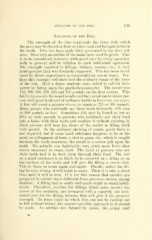Page 521 - My FlipBook
P. 521
STRENGTH OF THE BITE. 245
Strength op the Bite.
The strength of the bite represents the force witli which
the jaws may be closed on food or otlier material brought between
the teeth. This has been quite fully presented in the first vol-
ume. Here only au outline of the main facts need be given. This
is to be considered, however, with great care by every operator,
both in general and in relation to each individual operation.
The strength required in fillings, bridges, crowns, etc., is very
much greater than was formerly supposed. This has been devel-
oped by direct experiment in comparatively recent times. Per-
haps this example will show best the ordinary range of the force
of the bite. Half a dozen students were called to exhibit their
power by biting upon the gnathodynamometer. The result was
155, 190," 250, 220, 225 and 150 pounds on the first molars. This
fairly represents the usual results and the variations in stress per-
sons with good teeth and of ordinary habits in their use, can exert.
A few will exert a greater stress, as much as 275 or 300 pounds.
Many people who habitually use their teeth delicately, will stop
at 100 jiounds or less. Sometimes this may be found as low as
fifty or sixty pounds in persons who habitually pat their food
into a bolus with their teeth and swallow it without chewing it.
Such persons will bear the blows of the mallet in filling teeth
very poorly. In the ordinary chewing of meats, great force is
not required, but if some hard substance happens to be in the
meat, as a fragment of bone, a shot in game, etc., which is caught
between the teeth unawares, the result is a severe jolt upon the
teeth. We actually use, habitually, very much more force than
seems necessary to crush food. The habit of persons who use
their teeth best is to dash them through their food. The jolt
on a hard substance is as likely to be received on a filling as on
the surface of the tooth and will give the falling a severe test.
This is liable to occur again and again. Finally, unless the fill-
ing be very strong, it will begin to move. Then it is only a short
time vmtil it will be lost. It is for this reason that cavities are
prepared in certain ways different from previous custom among
dentists. A filling that is really well made ought to stand indefi-
nitely. Therefore, cavities for fillings which must receive the
stress of the occlusion, are prepared with a squarely cut hori-
zontal seat for the falling, because that will give it the greatest
strength. In those cases in which this can not be carried out
in full without injury, the nearest possible approach to it should
be made. As cavities are formed by caries, the pulpal wall
34


